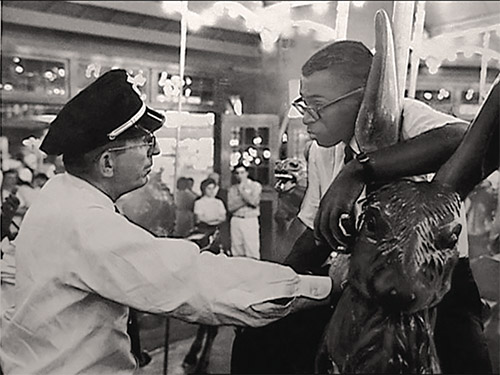“Ain’t No Back to a Merry-Go-Round”

“Ain’t No Back to a Merry-Go-Round” Recalls Little-Known Protest in Summer of 1960
Summertime amusement parks filled with roller coasters, carousels, cotton candy, and dodgem cars are so much a part of many childhood memories. That’s one of the reasons the documentary Ain’t No Back to a Merry-Go-Round is so eye-opening and profound.
Through interviews and archival footage, director Ilana Trachtman examines a little-known chapter in the civil rights struggle of the 1960s. A small band of Black and white, mostly Jewish, activists in the summer of 1960 picketed the entrenched segregation at Glen Echo Amusement Park in suburban Washington, D.C., enduring arrests and counter-protests by Nazis. But by the following year, the protestors succeeded in dismantling fifty-one years of segregation at the popular park.
Ain’t No Back to a Merry-Go-Round, which recently screened in several film festivals, takes its title comes from the 1942 Langston Hughes poem “Merry-Go-Round,” that begins:
Where is the Jim Crow section
On this merry-go-round,
Mister, cause I want to ride?
Emmy Award-winning producer/director Trachtman opens the film with an introduction to the park, built in 1909 in Glen Echo, Maryland, with vintage footage of its pool, concessions and rides, all set to a radio advertisement that urged, “Come One, Come All.” Only that was far from the truth. Interviews with Black residents recount years of watching from outside the gate as white kids enjoyed summer afternoons and birthday parties at the park.

Pictures, Inc.
The nation’s capital was “a deeply segregated town,” says Congresswoman Eleanor Holmes Norton, who joined Howard University students in 1960 when a handful of them formed a group called NAG (Non-Violent Action Group) and began picketing outside the park entrance. There are present day interviews with former students including Dion Diamond, Hank Thomas, and Janet Lewis who eloquently detail the confrontations and arrests they experienced during that summer. One jarring news clip shows uniformed security guard Francis Collins refusing the students admission with a terse “this park is whites only.” When their white counterparts bought tickets, police arrived and arrested five Black students for riding the carousel.
One of the most powerful revelations in the film is the crucial role that white, Jewish residents from a nearby community called Bannockburn played in the desegregation fight. Bannockburn was established in 1946 as a utopian refuge because, says resident and activist Esther Delaplaine, most real estate in Washington, D.C., was off-limits to Jews and Catholics, not to mention Blacks.
Bannockburn became a “haven” for many Jewish families including those who’d survived the Holocaust. It’s sobering to realize that the horrors of World War II were just fifteen years removed from 1960. It is particularly chilling to watch news footage of the American Nazi party descending on Glen Echo Amusement Park in counter-protest, hoisting virulent racist and antisemitic signs. In the film, interviewee Hank Thomas recalls that “two of the Jews on the line were Auschwitz survivors.” When Thomas asked what made them join the protest, the reply was that when the Nazis came for the Jews “no one stood up for us.”
It was an alliance both natural and complex. The protestors learned that Glen Echo park was owned by two Jewish brothers, Samuel and Abram Baker, who claimed their business would suffer if they integrated the park. “When I found that out, I took it very personally,” recalls Jewish picketer Martin Schain who was arrested with four others during that summer when they ventured to the park’s concession area and sat at the counter.
The film includes scenes of some of the activists today as they continue to educate young people about the civil rights movement. Thomas is shown at the King Center in Atlanta where he tells his young audience about the Glen Echo action. “American Jews were our most important allies in the civil rights movement,” he says. “So whenever you hear anyone, especially a person of color, say anything resembling antisemitism, I want you to tell them that they are talking about our most important allies.”
The film closes by listing numerous actions that followed the desegregation of Echo Park, including the fifteen-month campaign in deeply segregated St. Augustine, Florida.
Boston filmmaker Clennon L. King’s “Passage at St. Augustine: The 1964 Black Lives Matter Movement That Transformed America” (2015) is an important documentary on these events. It includes an interview with longtime Roxbury resident Mimi Jones, who died in 2020 at age seventy-three. As a teenager, Jones participated in the 1964 “swim-in” at the pool of the segregated Monson Motor Lodge in St. Augustine. Motel owner James Brock responded by pouring a bottle of muriatic acid into the water next to the swimmers. Jones is seen screaming in a famous photograph of the incident, a moment that’s revisited in King’s essential film.
Entertainment journalist Loren King writes for many regional and national outlets. She is a member and past president of the Boston Society of Film Critics and a reviewing member of the Alliance of Women Film Journalists.
